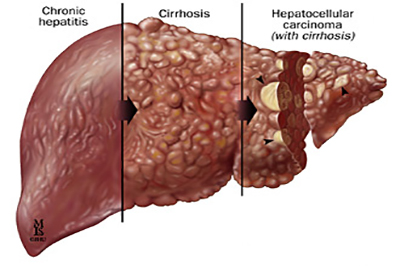Liver Cirrhosis:
Liver Diseases and Their Complications:
Liver Cirrhosis:
Liver cirrhosis is the irreversible end result of fibrotic scarring and regeneration of liver cells. It is the liver’s response to harmful factors of inflammatory, toxic, metabolic, or congestive origin. When cirrhosis occurs, the normal lobular structure of the liver is replaced by bands of fibrous tissue surrounding nodules formed from regenerating liver cells. This leads to increased pressure in the portal vein and changes within the liver. The liver cells’ function is also impaired due to decreased blood flow and the continued direct harmful effects on the cells.
Liver cirrhosis is the 15th leading cause of death due to disease, causing the death of approximately 26,000 people annually.
Causes:
- Alcoholic Hepatitis (resulting from alcohol consumption):
- Cirrhosis is commonly associated with chronic alcohol addiction in many individuals, but alcohol consumption is not the only cause.
- Alcohol-related cirrhosis usually occurs after long periods of heavy drinking.
- The amount of alcohol that causes liver damage varies from person to person; for women, consuming alcohol two to three times a day can lead to cirrhosis, while for men, it is three to four times a day.
- Alcohol damages the liver by preventing it from metabolizing proteins, fats, and sugars.
- Hepatitis C:
- Hepatitis C is one of the most common causes of chronic liver disease, including cirrhosis. The virus causes inflammation of liver cells, and after a long period of chronic infection, the inflamed liver turns into a cirrhotic liver.
- Chronic Coinfection with Hepatitis B and D Viruses:
- Hepatitis B infection is a common cause of cirrhosis worldwide, though it is less common in the United States and Western countries.
- Hepatitis D infection only affects individuals with hepatitis B, and coinfection with both viruses becomes chronic, causing greater liver damage.
- Autoimmune Hepatitis:
- This occurs when the immune system attacks the liver, leading to inflammation and destruction of liver cells, which eventually turns the liver into a cirrhotic liver.
- Non-Alcoholic Steatohepatitis (NASH):
- NASH is caused by the accumulation of fat in the liver, leading to the formation of scar tissue. It is commonly associated with diabetes, obesity, corticosteroid treatment, or dietary protein imbalances.
- Bile Duct Obstruction:
- When the bile duct carrying bile out of the liver becomes blocked, bile backs up into the liver, causing tissue damage.
- In infants, the common cause is “biliary atresia,” where the bile duct is absent or damaged.
- In adults, blockage may occur due to primary or secondary biliary cirrhosis following gallbladder removal.
- Drugs, Toxins, and Parasitic Infections:
- Reactions from prolonged use of certain drugs.
- Continuous exposure to toxins from environmental pollutants.
- Parasitic infections like schistosomiasis.
Symptoms:
- Many individuals with cirrhosis may not show symptoms in the early stages.
- As healthy tissue turns into scar tissue, liver failure begins to occur, leading to the following symptoms: general weakness, loss of appetite, weight loss, abdominal pain, and the appearance of spider-like blood vessels on the skin (spider angiomas).
- Symptoms progress as the condition worsens.
Symptoms and Problems Resulting from the Progression of Cirrhosis:
- Edema or Ascites:
- Occurs when the liver fails to produce the protein albumin, leading to water accumulation in the legs (edema) or abdomen (ascites).
- Increased Bleeding (Coagulopathy):
- A lack of production of proteins necessary for blood clotting leads to easy bleeding.
- Increased Bilirubin in the Blood (Jaundice):
- Yellowing of the skin and eyes due to the liver’s reduced efficiency in absorbing bilirubin from the blood.
- Itching:
- Accumulation of bile and its derivatives in the skin leads to severe itching.
- Gallstones:
- Cirrhosis prevents bile from reaching the gallbladder, leading to the formation of gallstones.
- Increased Toxins in the Blood and Brain:
- A damaged liver cannot remove toxins from the blood, leading to their accumulation in the blood and brain, causing personality changes, coma, or even death.
- Increased Sensitivity to Treatment:
- The liver’s slow ability to eliminate excessive drug doses leads to increased sensitivity to treatment and side effects.
- Increased Portal Vein Pressure:
- Leads to increased pressure in the portal vein and the formation of varices in the esophagus and stomach.
- Insulin Resistance and Type 2 Diabetes:
- Cirrhosis leads to insulin resistance, resulting in type 2 diabetes.
- Liver Tumor (Cancer):
- Cirrhosis can lead to the development of a tumor (cancer) in the liver cells.
Diagnosis:
- Cirrhosis can be diagnosed through symptoms, laboratory tests, medical history, or physical examination.
- The diagnosis can be confirmed by imaging (CAT, ultrasound, MRI) or liver scan using radioactive isotopes.
- Confirmation of the diagnosis is achieved through a liver biopsy for microscopic examination.
Treatment of Liver Cirrhosis:
- Destroyed liver cells cannot be replaced, but cirrhosis can be stopped, and the resulting damage can be reduced.
- Treatment depends on the cause and the damage caused by cirrhosis.
- Alcohol-related cirrhosis is treated by stopping alcohol consumption, while cirrhosis caused by hepatitis is treated by addressing the underlying viruses.
- It is advised to manage the cause, follow a healthy diet, and abstain from alcohol.
- Treatment also includes managing complications such as ascites and bleeding.

